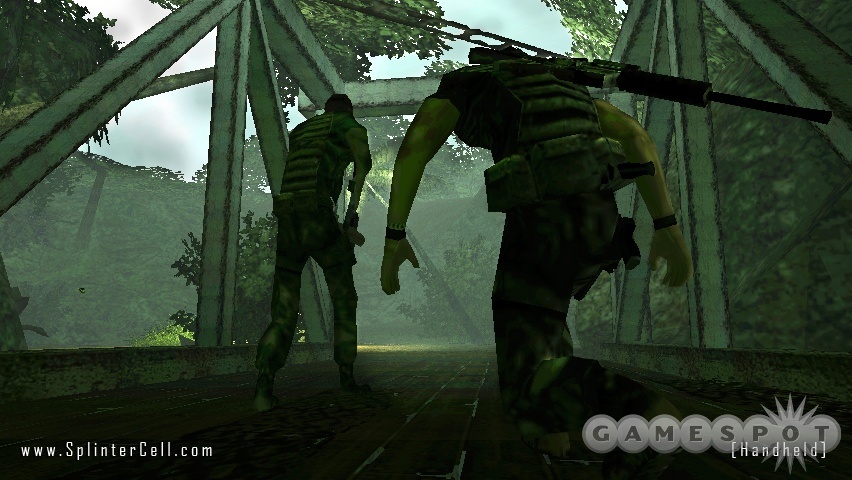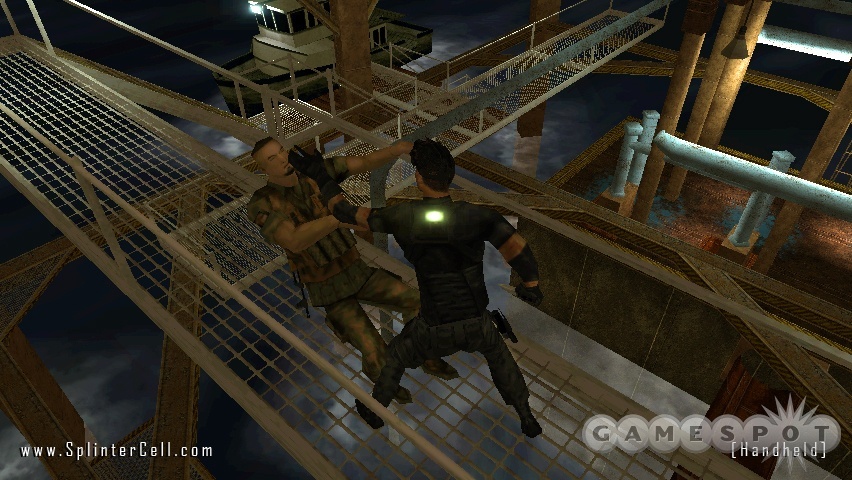Splinter Cell Essentials Hands-On
Sam Fisher prowls the portable scene with his first foray on the PSP. We get hands-on with the stealthy operative.
After exploding onto the scene three years ago, Tom Clancy's Splinter Cell has become an established video game franchise. Sam Fisher has made appearances on various handhelds, like the Nintendo DS, the N-Gage, and even mobile phones, but Splinter Cell Essentials will be the first time he has reported for duty on the Sony PlayStation Portable. From our hands-on time with a near-finished build of the game, Essentials promises to be a pretty close representation of the home console experience in terms of design.
The game starts you off in the year 2009, just around the time of Splinter Cell Double Agent, the upcoming game for home consoles and the PC. Sam is sneaking into the graveyard where his daughter, recently killed in a car accident, has been buried. This quick tutorial mission ends with Fisher being captured at the gravesite and a multi-frame cutscene showing Sam being taken into custody. There's a good amount of voice in Essentials to set the story, though if our ears don't deceive us, it sounds as though Michael Ironside and some of the other original voice actors aren't doing the voices for this version of the game. The cutscenes with Sam being taken into custody and interrogated will serve as a vehicle to present Essentials' missions, which are flashbacks of Sam's previous service in the Navy SEALs and Third Echelon.

The first mission is set in Colombia way back in 1992, with Fisher still in the SEALs. Fisher's commanding officer has been captured by guerrillas, and he's not interested in waiting for a full rescue operation. Against the direct order of the commanding officer of American forces in the area, you control Fisher as you lead a solo rescue of your commander. The first part of the mission has you sneaking out of the US Army base, past watchful Rangers on station. You'll find that Fisher's movements and abilities are similar to those in the home console games. There's a light and sound meter to give you an idea of how detectable you are. You can put your back to a wall and peer around corners or just crouch and reduce your visibility. The game seems to do a pretty decent job of showing you lit and dark areas for you to prowl around in, though you do of course have lowlight goggles to improve your own visibility.
Once you escape the US base, you'll need to infiltrate the guerrillas' bunker to find the prisoner. As you make your way through the jungle, grabbing, interrogating, and knocking out enemies, you eventually get captured yourself and have to escape out of your own cell. Luckily, you can do Fisher's signature athletic split-jump maneuver to make your way to a high vent and shimmy along a pipe to the next room. The interior sections of the bunker look a lot better in this build than the outdoor areas, which sometimes don't show quite enough detail to make it clear where you can move or climb.
Since the PSP lacks a second analog stick to control the camera angle, you have to hold down the circle button to change the analog stick from movement to camera-adjustment duty. Having to switch back and forth does slow down the game a smidgen, but once you get used to it, it seems to become second nature. This does seem to be inconvenient in cases where you get surprised by an enemy--you have to choose between running away and moving the camera to locate him. Wielding your gun is also a somewhat dicey affair, as the analog stick on the PSP defaults to aiming, and the four face buttons switch to movement, allowing you to strafe back and forth around cover. It doesn't offer quite as fine control as having two analog sticks, but it's better than not being able to move at all. Still, we're fairly impressed with how the controls have translated over to the PSP, and you'll even get to engage in lock-picking and trap-disarming minigames where you rotate or wiggle the analog stick.

The first couple of missions in the game are fairly lengthy, but they are split up into several parts where the game has to stop and load the next section. The load times in the game are currently about on par with those in other PSP games.
From what we've played so far, Essentials shows a good amount of promise, offering a reasonably faithful translation of the original gameplay style on a portable platform. The graphics, at least in the indoor portions, are looking good at this point, and we're pleased at the quality of sound effects and the amount of voice acting we've heard thus far. There are some issues with clipping that could stand to be cleaned up, so hopefully those will be addressed before the game ships later this month. Stay tuned to GameSpot for more details on Tom Clancy's Splinter Cell Essentials as they become available.
Got a news tip or want to contact us directly? Email news@gamespot.com
Join the conversation